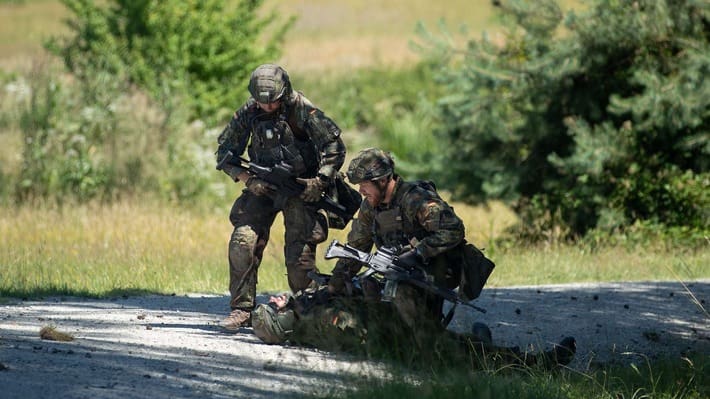Bundeswehr medical service relies on civil-military cooperation in the care of the wounded
This summer, the medical service of the German Armed Forces presented its skills in the care of the wounded under conditions of national and alliance defence at the Information and Teaching Exercise (IL├ť SanDstBw) in Feldkirchen, Lower Bavaria. A central element of the exercise was the intensive involvement of civilian rescue forces for the first time in order to realistically represent the rescue chain in a war scenario. The exercise was based on current findings, especially from the war in Ukraine, and showed the challenges of modern combat scenarios such as drone attacks.
In one exercise scenario, three soldiers were wounded by a drone that dropped a grenade ÔÇô a scenario that mirrors the threat from the air as observed in the Ukraine conflict. A first responder immediately took over the care at the scene before the wounded were taken to a collection point and taken over by paramedics from treatment level 1, a rescue station. Seriously injured people were then transferred to treatment level 2, a rescue center, where surgical interventions are possible. The exercise illustrated the process of the rescue chain from first aid to forwarding to civilian clinics.
One focus of the IL├ť 2025 was enhanced civil-military cooperation (CMC). The Federal Office of Civil Protection and Disaster Assistance (BBK) coordinated the distribution of up to 500 wounded, who arrive by train, to regional hospitals. Aid organizations such as the German Red Cross, the Johanniter and the Order of Malta took over the screening and transport of the patients. This cooperation was highlighted as essential for coping with large numbers of wounded in the event of a crisis.

Surgeon General Ralf Hoffmann, Commander of the Central Medical Service, emphasized the need to prepare the health system for war scenarios. General Staff Physician Johannes Backus, Commander of the Health Care Command, underlined the importance of networking with civilian partners as a central challenge for the care of the wounded. BBK President Ralph Tieser emphasized that a crisis-proof rescue chain can only be guaranteed through close coordination between the civilian and military sides. The exercise showed the first successes of the ZMZ, for example in the distribution of wounded people to hospitals, but also made clear the need for further deepening of this cooperation.
Innovative elements such as the use of the “Grille” drone for rapid transports of wounded between the assembly point and treatment facilities underlined the progress in tactical wounded care. According to the Bundeswehr, the IL├ť SanDstBw 2025 made it clear that close cooperation with civilian partners and the use of modern technologies are crucial to ensure operational readiness and security of supply in an emergency.
Read Also:
INTRODUCING: The Bundeswehr Health Care Command – MedLabPortal
Editor: X-Press Journalistenb├╝ro GbR
Gender Notice. The personal designations used in this text always refer equally to female, male and diverse persons. Double/triple naming and gendered designations are used for better readability. ected.




